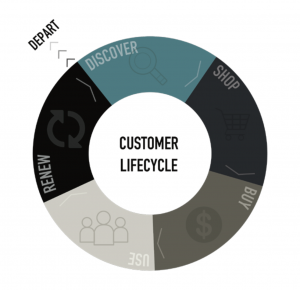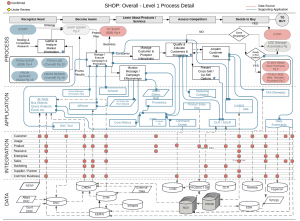The words “Journey Maps” have become standard customer experience terminology. But, why does it mean different things to different organizations. The practice of journey mapping is quite different based on whom you are talking to. We’ve broken down journey mapping to help you pick what’s best for you.
AN OVERVIEW OF JOURNEY MAPPING
Journey maps can be very powerful, visual communication tools to share with employees and partners to understand the customer’s outside in perspective, including touch points that are most important, pain points, customer emotions, and the multi- channel experience. When documenting the journey from the customer perspective, new ideas and opportunities are uncovered to improve the experience and acquire / retain more customers.
When journey maps are paired with personas, they provide even richer detail and opportunities. Personas typically represent a target customer type or segment and can include information on their attitudes, behaviors, aspirations, lifestyle, financial situation, channel preferences and other contextual information to bring that customer to life. Customer personas may go through the same phases of a particular journey, but their needs, wants, and preferences can be very different. It is critical to understand your different customer personas in order to create differentiated and even individualized experiences.
| WHAT | WHY | HOW | RESULT | |
| Tier 1 Customer Lifecycle | A high level view of the end to end experience that highlights touch points and channels. | Shows the entire experience of a customer with your company and identifies pain points and opportunities |
Cross-functional workshops with customers and key stakeholders. Journey Mapping software or any tool that allows you to document and categorize touchpoints, channels, notes and artifacts about an experience. | Company: Overview of everywhere an experience is delivered and the interdependencies within the entire experience across sales, marketing, service, operations, communications, and IT. Customer: Ability to create a seamless experience, address pain points across channels, and present one brand. |
| Tier 2 Moment of Truth Map | A magnified view of a specific, critical interaction with your customer. | Not all customer interactions are created equal. Spending time on the critical moments is important to make sure you get it absolutely right. | In-depth qualitative and quantitative research, paired with existing VoC and operational metrics, expert interviews, cross-functional workshops and stakeholder discussions in order to take action on journey map initiatives. | Company: An understanding of emotional drivers, customer goals, actions, behaviors, attitudes, and feelings of customers and the pain points, opportunities and associated initiatives to create differentiated experiences. Customer: Create a seamless experience for customer when it matters most so they can be more deeply connected and an advocate for a brand. |
| Tier 3 Experience Capability Map | A view of the customer journey, but also the technical and business capabilities required to deliver the experience. |
This allows you to connect the dots from the desired customer experience to the business capabilities needed to deliver it. | Cross-functional workshops to identify and ideate the processes, applications, data, and information needed to deliver the experience. | Company: An understanding of how to deliver and support an existing or new experience from a people, process and technology perspective. Customer: Access to more relevant and timely information, integrated experiences and more robust functionality and personalization. |
Tier 1: Customer Lifecycle
The easiest and most cost effective way to start mapping is create a Customer Lifecycle and document customer touch points and channels for each lifecycle phase. There are some journey mapping software tools that can help with this (not required), but you still need a solid approach and previous experience to be successful. Creating a Tier 1 map can be done by getting a cross functional team and a few customers in a room to document the touch points customers have with your brand. Remember, this is from the customer’s perspective. Tier 1 maps typically document the current state experience and is a great way to quickly uncover pain points and opportunities. This is also the first step to identifying Moments of Truth, or the most critical interactions customers have with your brand that greatly influence whether they choose to purchase, leave or recommend your company. A Tier 1 map can be completed in a week for some companies while others may take several weeks or even months.

Tier 2: Moment of Truth Map
In order to create a more in depth understanding of a customer persona, a moment of truth, life event or specific phase within the customer lifecycle, a Tier 2 journey map can be used and typically requires primary customer research. For example, a warranty provider may want to understand the experience when a customer breaks their mobile phone and needs to get it replaced, or a health plan wants to explore the experience of customers approaching age 65, a key trigger to purchase Medicare products. Andrew Reise has a proven approach to uncovering in depth insights in order to create Tier 2 journey maps.
First, EXPLORE the entire customer ecosystem by analyzing existing voice of the customer data (surveys, market research, call center data) and conducting extensive secondary research. Next, identify and interview expert authorities across the customer ecosystem to UNCOVER insights into the attitudes, behaviors and habits of customer’s. Then, IMMERSE yourself into the customer’s world by leveraging primary research techniques such as in depth interviews, ethnographic research, or online journaling to uncover customer aspirations, emotions, and Moments of Truth. Finally, analyze all the data points and insights learned to develop customer personas and journey maps to visually COMMUNICATE who this customer is and their holistic experience journey.
Tier 3: Experience Capability Map
Journey mapping pros are now moving towards multi dimensional journey maps that not only show the customer’s journey, but also the back office processes, systems and data required to deliver the experience. These are multi-dimensional maps that identify and align the customer touch points across the journey with the company capabilities required to deliver a differentiated experience. For example, we create P.A.I.D diagrams, which stands for Process Application/Integration or Information/ Data. This process identifies all the ‘behind the scenes’ process, systems and data that actually deliver the experience for the customer. It is an excellent exercise to open the eyes of back office owners that may not think about or know how their job impacts the end consumer.

Is your company ready to improve the customer experience? Request a consultation to speak with one of our experts.



